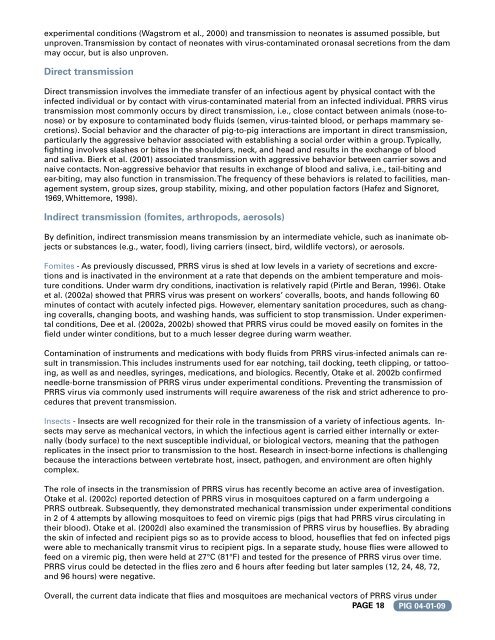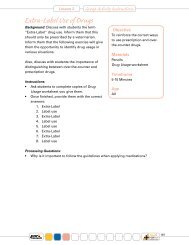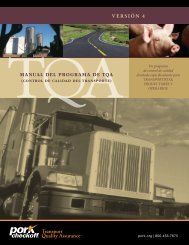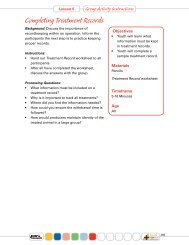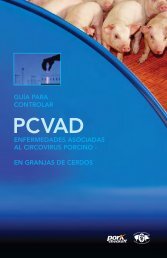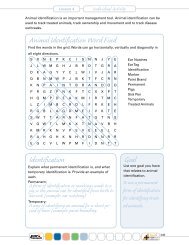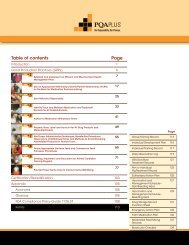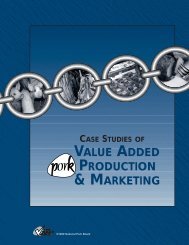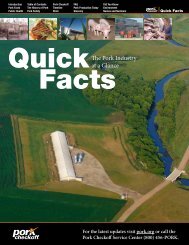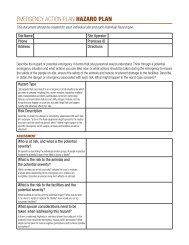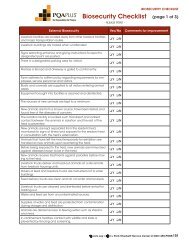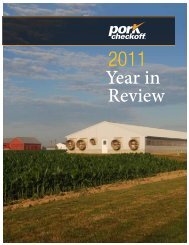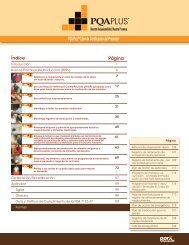PRRS Compendium Producer Edition - National Pork Board
PRRS Compendium Producer Edition - National Pork Board
PRRS Compendium Producer Edition - National Pork Board
You also want an ePaper? Increase the reach of your titles
YUMPU automatically turns print PDFs into web optimized ePapers that Google loves.
experimental conditions (Wagstrom et al., 2000) and transmission to neonates is assumed possible, but<br />
unproven. Transmission by contact of neonates with virus-contaminated oronasal secretions from the dam<br />
may occur, but is also unproven.<br />
Direct transmission<br />
Direct transmission involves the immediate transfer of an infectious agent by physical contact with the<br />
infected individual or by contact with virus-contaminated material from an infected individual. <strong>PRRS</strong> virus<br />
transmission most commonly occurs by direct transmission, i.e., close contact between animals (nose-tonose)<br />
or by exposure to contaminated body fluids (semen, virus-tainted blood, or perhaps mammary secretions).<br />
Social behavior and the character of pig-to-pig interactions are important in direct transmission,<br />
particularly the aggressive behavior associated with establishing a social order within a group. Typically,<br />
fighting involves slashes or bites in the shoulders, neck, and head and results in the exchange of blood<br />
and saliva. Bierk et al. (2001) associated transmission with aggressive behavior between carrier sows and<br />
naive contacts. Non-aggressive behavior that results in exchange of blood and saliva, i.e., tail-biting and<br />
ear-biting, may also function in transmission. The frequency of these behaviors is related to facilities, management<br />
system, group sizes, group stability, mixing, and other population factors (Hafez and Signoret,<br />
1969, Whittemore, 1998).<br />
Indirect transmission (fomites, arthropods, aerosols)<br />
By definition, indirect transmission means transmission by an intermediate vehicle, such as inanimate objects<br />
or substances (e.g., water, food), living carriers (insect, bird, wildlife vectors), or aerosols.<br />
Fomites - As previously discussed, <strong>PRRS</strong> virus is shed at low levels in a variety of secretions and excretions<br />
and is inactivated in the environment at a rate that depends on the ambient temperature and moisture<br />
conditions. Under warm dry conditions, inactivation is relatively rapid (Pirtle and Beran, 1996). Otake<br />
et al. (2002a) showed that <strong>PRRS</strong> virus was present on workers’ coveralls, boots, and hands following 60<br />
minutes of contact with acutely infected pigs. However, elementary sanitation procedures, such as changing<br />
coveralls, changing boots, and washing hands, was sufficient to stop transmission. Under experimental<br />
conditions, Dee et al. (2002a, 2002b) showed that <strong>PRRS</strong> virus could be moved easily on fomites in the<br />
field under winter conditions, but to a much lesser degree during warm weather.<br />
Contamination of instruments and medications with body fluids from <strong>PRRS</strong> virus-infected animals can result<br />
in transmission. This includes instruments used for ear notching, tail docking, teeth clipping, or tattooing,<br />
as well as and needles, syringes, medications, and biologics. Recently, Otake et al. 2002b confirmed<br />
needle-borne transmission of <strong>PRRS</strong> virus under experimental conditions. Preventing the transmission of<br />
<strong>PRRS</strong> virus via commonly used instruments will require awareness of the risk and strict adherence to procedures<br />
that prevent transmission.<br />
Insects - Insects are well recognized for their role in the transmission of a variety of infectious agents. Insects<br />
may serve as mechanical vectors, in which the infectious agent is carried either internally or externally<br />
(body surface) to the next susceptible individual, or biological vectors, meaning that the pathogen<br />
replicates in the insect prior to transmission to the host. Research in insect-borne infections is challenging<br />
because the interactions between vertebrate host, insect, pathogen, and environment are often highly<br />
complex.<br />
The role of insects in the transmission of <strong>PRRS</strong> virus has recently become an active area of investigation.<br />
Otake et al. (2002c) reported detection of <strong>PRRS</strong> virus in mosquitoes captured on a farm undergoing a<br />
<strong>PRRS</strong> outbreak. Subsequently, they demonstrated mechanical transmission under experimental conditions<br />
in 2 of 4 attempts by allowing mosquitoes to feed on viremic pigs (pigs that had <strong>PRRS</strong> virus circulating in<br />
their blood). Otake et al. (2002d) also examined the transmission of <strong>PRRS</strong> virus by houseflies. By abrading<br />
the skin of infected and recipient pigs so as to provide access to blood, houseflies that fed on infected pigs<br />
were able to mechanically transmit virus to recipient pigs. In a separate study, house flies were allowed to<br />
feed on a viremic pig, then were held at 27°C (81°F) and tested for the presence of <strong>PRRS</strong> virus over time.<br />
<strong>PRRS</strong> virus could be detected in the flies zero and 6 hours after feeding but later samples (12, 24, 48, 72,<br />
and 96 hours) were negative.<br />
Overall, the current data indicate that flies and mosquitoes are mechanical vectors of <strong>PRRS</strong> virus under<br />
PAGE 1 PIG 04-01-09


